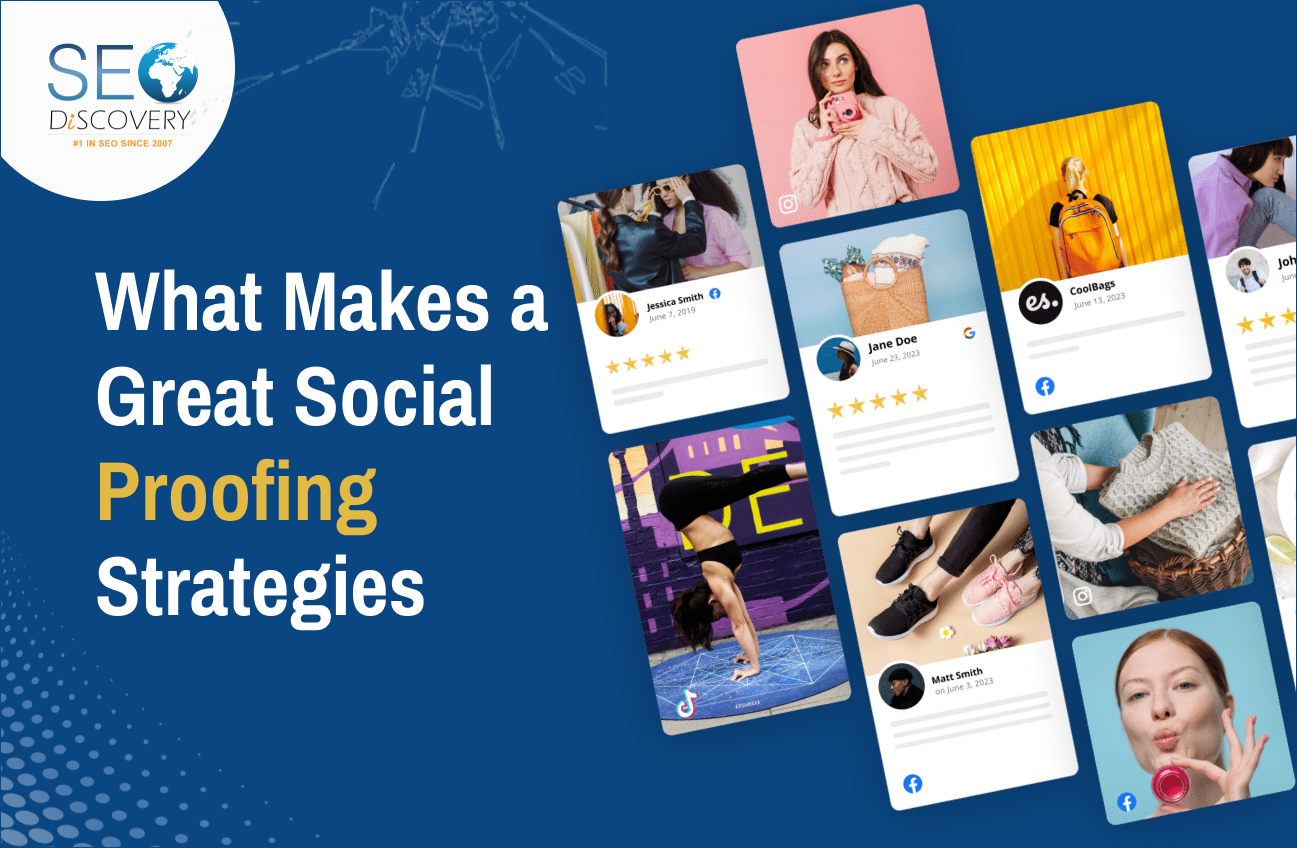In the abundance of choices, choosing a particular product is challenging. In this case, customers often go with familiar names or other customers’ recommendations. We’ve all experienced it someday, right?
It seems like a simple question, but the answer runs deeper than you might think. Buying is a psychological process and understanding can help you better predict and even influence customer behavior. This is called social proof.
This blog provides an insightful overview to help you master social proof techniques and become a marketing pro.
Stay Tuned!
What Is Social Proof in Digital Marketing?
Social proof marketing is a strategy that increases the chances of your digital world. Basically, it’s a psychological phenomenon in which people look to the actions and behaviors of others to guide their own decisions.
In short, it’s the idea that if many people are using a particular product or service, it must be the right choice. This concept plays a crucial role in consumer behavior, especially in an age where trust and credibility are paramount.
For example, new customers who are not familiar with your product are more likely to trust and choose a product or service if they see positive reviews, testimonials, or high engagement on social media.
Why Is Social Proofing Important?
Social proof is a game-changer tool that influences people’s choices, especially in B2B marketing. When the targeted customers see that a brand has strong reviews, they’re more likely to trust it.
The data shows that 92% of B2B buyers are more likely to purchase a product if they read a positive review about it. If a company’s social media shows 1000+ satisfied customer reviews or testimonials, this social proof effect increases trust instantly.
On the other hand, Social proof marketing on social media is especially useful in building trust and credibility. Think of it as a digital word-of-mouth where reviews, testimonials, and case studies help build social proof. Seeing that others, top-rated companies or influencers, have used a product makes new buyers more comfortable.
Hence, Brands use social proof campaigns strategically to influence buying decisions. For example, a software brand might highlight “Used by 10,000+ businesses globally” in its branding to build trust and stand out in a crowded market. Additionally, featuring user-generated content, like photos or stories, makes the social proof concept relatable, enhancing brand credibility.
Comprehensive Guide to Effective Social Proofing Strategies
Implementing social proof strategies can dramatically improve your brand’s credibility and foster trust with your audience. In this section, we take a deeper look at some powerful strategies for building social proof and the benefits they can bring to your business.
1. Leverage Customer Testimonials and Reviews
What It Is:
Customer testimonials and online reviews act as endorsements from previous buyers. They’re vital components of social proof.
How to Implement:
Collect Feedback: After a purchase, encourage your customers to leave a review about your services or product. You can send follow-up emails requesting feedback.
Showcase Reviews: Create a dedicated section on your website for customer testimonials. To do this, you can use platforms like Trustpilot or Google Reviews to display aggregated ratings.
Highlight Specifics: Include details about the problem your product solved and how the customer benefited. This specificity enhances credibility.
Benefits:
- Builds trust by showing potential customers that others have had positive experiences.
- Helps overcome buyer skepticism, particularly in B2B social proof, where decisions often require more consideration.
2. Utilize Case Studies Effectively
What It Is:
Case studies are detailed analyses of how your product or service helped a specific customer.
How to Implement:
Identify Success Stories: Choose clients who have seen significant results using your product.
Format and Content: Structure the case study to include the client’s challenge, the solution you provided, and measurable outcomes (e.g., increased sales, improved efficiency).
Visual Elements: Include charts or graphs to represent success metrics, making it more engaging visually.
Benefits:
- Provides potential clients with concrete evidence of your product’s effectiveness.
- Shows your expertise and deep understanding of your industry.
3. Show Off Your Social Media Metrics
What It Is:
The number of followers, likes, shares, and comments on your social media profiles serve as indicators of your brand’s popularity.
How to Implement:
Display Follower Counts: Show your follower count on your website and marketing materials.
Highlight Engagement: Use posts or stories that showcase user interactions with your content, such as re-shares or comments.
Create Shareable Content: Create content that your audience loves and shares with their friends. This will help your brand increase visibility and perceived popularity.
Benefits:
- Large followings can signal trustworthiness to potential customers.
- Active engagement shows that others find value in your offerings.
4. Collaborate with Influencers
What It Is:
Influencers have established trust with their audiences. Partnering with them can amplify your message and reach.
How to Implement:
Identify Relevant Influencers: Look for influencers within your industry whose audience aligns with your target market.
Develop Collaborative Campaigns: Collaborate on social proof campaigns, such as product reviews or tutorials, that showcase your brand.
Use Their Platforms: Take advantage of the influencer’s platform to introduce your brand to a new audience.
Benefits:
- Provides immediate credibility through association with a trusted figure.
- Expand your reach to new potential customers who trust the influencer’s recommendations.
5. Encourage User-Generated Content (UGC)
What It Is:
UGC is content created by your customers, such as photos or videos of them using your products.
How to Implement:
Create a Hashtag #: The hashtag sign facilitates customers’ sharing of their experiences using a specific hashtag related to your brand.
Feature UGC: Showcase user-generated content on your social media and website. This can be in the form of a gallery or dedicated posts.
Run Contests: Host contests encouraging users to submit their photos or stories for a chance to win a prize, thus generating more content.
Benefits:
Promotes a community around your brand.
Provides authentic, relatable content that resonates with potential customers.
6. Build a Community Around Your Brand
What It Is:
Creating a space for your customers to engage with each other can significantly enhance social proof.
How to Implement:
Social Media Groups: Make a group on Facebook or other forums where customers can share tips, experiences, and advice related to your products.
Host Events: Organize webinars or live Q&A sessions to foster interaction and discussion among users.
Encourage Engagement: Prompt discussions and sharing within the community to build stronger connections.
Benefits:
Creates a loyal customer base that actively promotes your brand.
New customers see existing customers’ positive experiences and feel more inclined to join.
7. Highlight Awards, Certifications, and Media Mentions
What It Is:
Awards and recognition from reputable organizations act as endorsements of your brand’s credibility.
How to Implement:
Showcase Awards: Create a dedicated “Awards” section on your website.
Leverage Media Mentions: If your brand has been featured in prominent publications, display those logos on your website to enhance credibility.
Incorporate into Marketing: Mention any certifications or awards in your email signatures and promotional materials.
Benefits:
- Establishes authority in your industry.
- Helps potential customers feel secure in choosing your brand over competitors.
8. Utilize Compelling Statistics
What It Is:
Statistics provide concrete evidence of your product’s effectiveness and popularity.
How to Implement:
Gather Data: Collect data on customer satisfaction, success rates, or market research that supports your claims.
Share Infographics: Create visually appealing infographics that present statistics in an easily digestible format.
Use in Marketing: Incorporate statistics into your social proof marketing strategy by sharing them in blog posts, newsletters, and social media content.
Benefits:
- Makes your claims more credible and persuasive.
- Engage your audience by providing interesting, informative content.
Let’s Get Started Your Social Proof In Your Marketing Strategy
It’s very important to take advantage of social proof for your brand visibility. In the above article, we have given ideas for social proofing.
You can use these ideas for your business. Even though you are looking for an agency that can do it for you, SEO Discovery is the one-stop agency for you.
They have 400+ experts who empower your brand and connect with your target audience in a way that truly matters.


